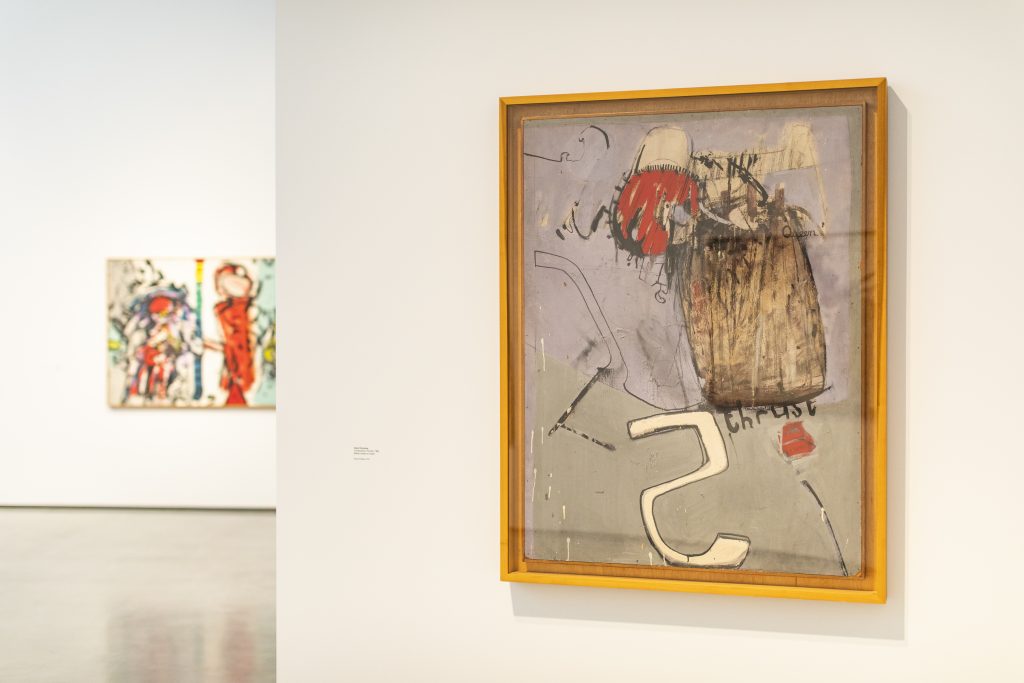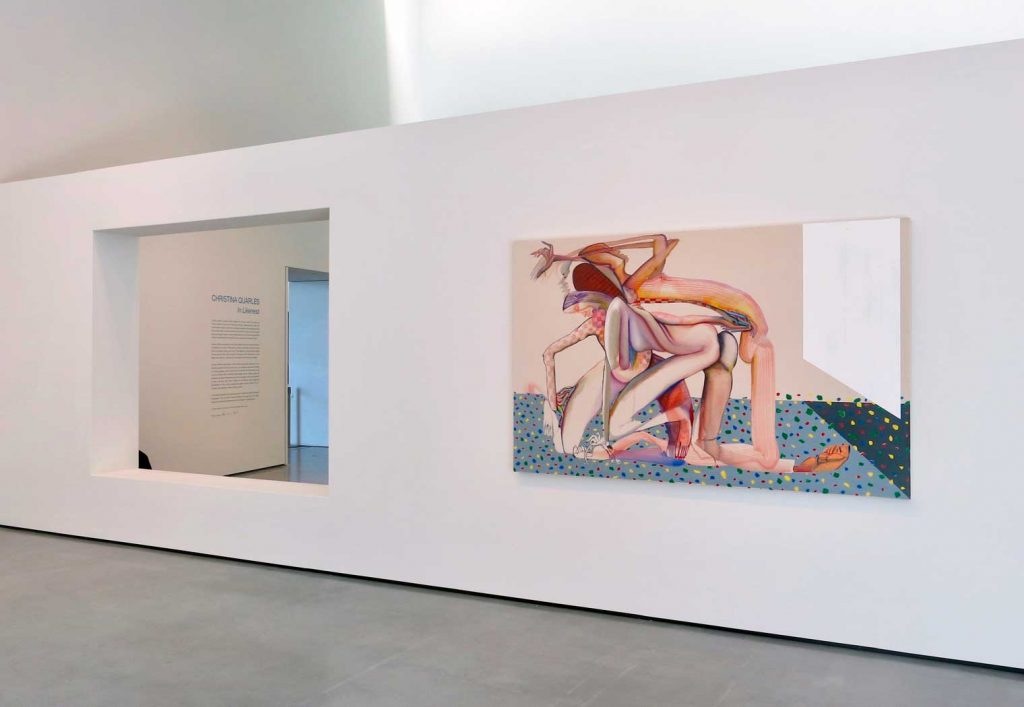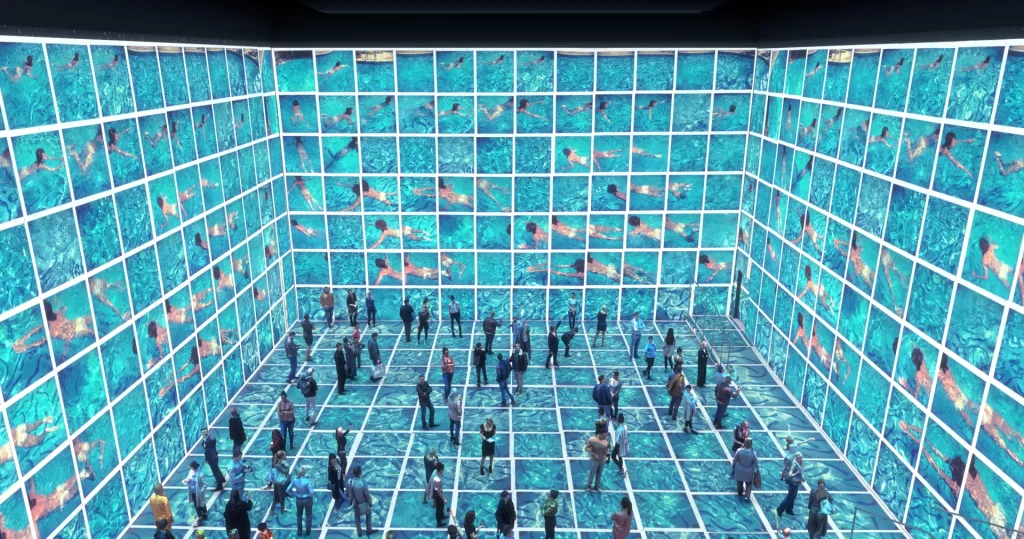Davie, Hockney and Quarles at Yorkshire’s Hepworth Wakefield
The UK gallery ties together early works by Alan Davie and David Hockney with Christina Quarles’ first European solo show

Stunning architecture strikes visitors arriving at Hepworth Wakefield Gallery in Yorkshire long before the art inside does. The David Chipperfield-designed building has a stark, neo-brutalist beauty that’s underlined by a verdant new garden created by Tom-Stuart Smith. Behind it, the grey concrete edifice of the gallery, whose shape echoes the statues by Barbara Hepworth that it’s named for, sits on the edge of the River Calder. Its unadorned exterior currently hides an explosion of color in the two exhibitions Alan Davie & David Hockney: Early Works and Christina Quarles: In Likeness, both on show until 2020.

“The Davie and Hockney exhibition came out of Wakefield history,” explains curator Eleanor Clayton. “Davie held what was called his breakthrough show here in 1958 (at what was then the Wakefield Art Gallery), and Hockney visited it. This would have been the first time that Hockney saw large-scale modernist works in the flesh, rather than as black-and-white reproductions, and the first time he got to see a modern artist like Davie.”
The exhibition begins by showcasing pieces that were on display in 1958, and reveals how they influenced Hockney’s short-lived stage of experimenting with abstraction. Not only are the pieces on display (many of which have rarely been shown before) beautiful, it’s also a revealing insight into how an artist’s work is shaped and shows a number of convergences between the two beloved British painters.

One room looks at how the key elements of text and graffiti in Davie’s work at the time made their way into Hockney’s abstract paintings, another at how Walt Whitman’s Leaves of Grass had a significant influence on both Davie and Hockney during the early ’60s.

Hepworth’s architecture makes wandering around the artworks extra joyful. In the final room of the exhibition, the two artists’ mutual interest in Egypt results in a juxtaposition of related pieces, enhanced by the natural light flowing in through large gallery windows. “Davie and Hockney operated between the schism of abstraction and figuration at the time,” explains Helen Little, independent co-curator of the show. “Another shared theme was fusing art of the ancient past with contemporary Egyptian culture.” Davie believed that ancient symbols could reveal universally accessible meaning, and combined symbols like the cross and the Egyptian ankh. For Hockney, the fascination lay in the methods used—he appropriated the techniques of Egyptian art, whose “illusionistic” and “flat” style appealed to him. Shown side by side, the artworks of the two different artists smartly illustrate these common viewpoints.

This last room also contains Hockney’s swan song to the early ’60s movement of heavily symbolic paintings, “Portrait Surrounded by Artistic Devices.” From then on, he would leave the abstract behind, moving toward figurative portraits of friends and acquaintances and his famously vibrant, sun-dappled depictions of California life.

These iconic California paintings (in particular “Mulholland Drive: The Road to the Studio“) transfixed the third artist on show at the Hepworth: Christina Quarles. “I’m thrilled to do a show here, because of the architecture and the history of the Hepworth Gallery, but also as I grew up near the Los Angeles County Museum of Art and used to go there and see Hockney’s works,” Quarles tells us.

In her first solo European show, Quarles’ paintings are hung in a way that plays with the architecture of the Hepworth Wakefield. A large window in a wall allows visitors to sit and look at the works in another room.

Quarles’ pieces, like those early Hockney pieces and the work of Davie at the height of his career in the ’60s, are inspired by the world surrounding the artist and often feature fragments of text from songs or poems. The glorious colors and use of a number of different techniques in her art (Quarles uses photography and sometimes a computer to manipulate her pieces) also ties in with the way Hockney and Davie experimented with form.
Quarles tells us, “I see my work as being portraits of living in a body, rather than looking at a body. Living in a gendered, racialized, queer body, and a way to express the ever-changing sense of yourself.”

It’s a fascinating, accomplished exhibition, and seeing it in the light of the Davie and Hockney show underlines not just what all three artists have in common, but how different they are. Moreover, the shows highlight the ways in which the world has changed since the ’60s—and what remains. Hockney’s abstract depictions of love were homosexual, not decriminalized until 1967 in the UK. Quarles’ paintings of loose-limbed women, their bodies tangled up together, address the dominance of a heteronormative, white male worldview in the history of painting. Their works are not just ways of painting, but the manifestation of an artist’s need to express another perspective on the world.
Hero image courtesy of The Hepworth Wakefield












